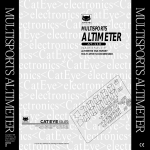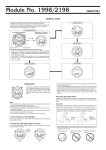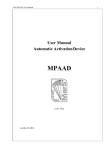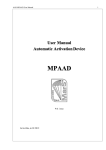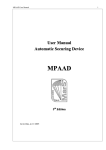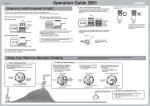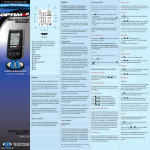Download Cateye ALTIMETER Instruction manual
Transcript
t Eye> electronics ectronics< C at Ey onics < C at Eye> el MULTISPORTS e>ALTIMETER electronics< C a ectronics< C at Ey < C at Eye> electron onics< C at Eye> el s< C at Eye> electr t Eye> electronics ectronics< C at Ey onics< C at Eye> el e> electronics< C a ectronics< C at Ey < C at Eye> electron ® AT-110 マルチスポーツアルティメータ ALTIMETRE MULTISPORT MULTI-SPORT-HÖHENMESSER MULTISPORTS ALTIMETER MODEL AT-110 Instruction Manual INTRODUCTION Thank you for purchasing CATEYE Model AT-110. This altimeter is designed to help quantify altitude data for vertical sports such as, skiing, hiking, climbing, mountaineering, hang-gliding, parasailing, ballooning, sail-planing and sky-surfing, etc. The patented temperature compensated pressure captures atmospheric pressure and gives accurate altitude reading in 1 meter or 5 foot resolution. Three types of measuring mode (Hike, Ski and Fly) allow for meaningful data collection for each sport. The screen has an EL (electroluminescent) backlight for night viewing. Features: • Displays altitude with 1 meter or 5 feet resolution up to 6000m or +20,000ft. • Temperature compensated atmospheric pressure sensor. • Measures atmospheric temperature. • Audible and visible alarm in the Fly Mode to easily note any ascent or decent. • Three types of measuring modes designed for the characteristics of different activities; (Hike, Ski and Fly). • Shows current altitude in the large display with clock time, temperature, stopwatch, speed of ascend/descend, altitude gain and loss, on the small display. • Displays LOG-Book data of highest trip altitude, lowest trip altitude, sum of ascends, sum of descends. • Preserves LOG-Book data in memory even after replacing battery. • Displays in feet or meters, fahrenheit or celsius. • EL (electro-luminescent) back-lit screen for viewing data at night. • Audible beep with each button operation. Before operating, thoroughly familiarize yourself with this manual so that you understand the functions completely. Please keep this manual, along with the warranty card, for future reference. INDEX FOR SAFE OPERATIONS (IMPORTANT) ------------------------------ 2 NAMES --------------------------------------------------------------------------- 2 PREPARATIONS 1. Battery Installation ------------------------------------------------------ 3 2. Data Scale Set Up ------------------------------------------------------ 3 3. Time Set Up -------------------------------------------------------------- 3 4. Attaching Wrist Band --------------------------------------------------- 3 5. Attaching to Your Body ------------------------------------------------ 3 HOW TO USE AS AN ALTIMETER 1. Functions and Button Operations ----------------------------------- 4 2. Hike Mode ---------------------------------------------------------------- 6 3. Ski Mode ------------------------------------------------------------------ 8 4. Fly Mode ---------------------------------------------------------------- 10 5. Altitude Correction ---------------------------------------------------- 12 BASIC KNOWLEDGE OF ALTITUDE MEASURING --------------- 12 TROUBLESHOOTING ------------------------------------------------------ 13 DAILY CARE ------------------------------------------------------------------ 13 SPARE ACCESSORIES --------------------------------------------------- 13 SPECIFICATIONS ----------------------------------------------------------- 14 LIMITED WARRANTY ------------------------------------------------------ 14 1 FOR SAFE OPERATIONS (IMPORTANT) For safe and appropriate use, always observe the following. Caution: • This altimeter is not intended to be a definitive measuring device. • Give due consideration to your surroundings. Don’t pay too much attention to the data on the screen when using. • Safely dispose of old batteries. Don’t place within reach of children. If swallowed, consult a physician immediately. Note: • Please note that atmospheric pressure is effected by the weather. The AT-110 calculates altitude from the changes in atmospheric pressure. Even during stable weather condition, the altitude reading may change as much as 40m or 130ft, over the course of the day. • Select the best-suited mode for your activity. • Never disassemble the main unit. It can not be re-assembled. • The main unit is loaded with highly sensitive components. A strong impact may result in malfunctions. • Never intentionally submerge the main unit under water. Although the main unit is water-resistant to normal weather conditions it is not designed to be used underwater. • Don’t leave the main unit exposed to direct sunlight for extended periods of time. • If the main unit is heated by strong direct sunlight, the temperature sensor inside of the main unit may give incorrect temperature readings. • The atmospheric pressure is continually changing. Thus, the data of the current altitude of one location might fluctuate from day to day depending on the weather. • The Current altitude should be calibrated (corrected) before each use. • Sudden temperature change such as moving from inside a heated building to a cold outside can cause temporary incorrect altitude data. • Static electricity might cause incorrect data. • In pressurized aircraft the unit will not give a correct altitude. • If the sensor cover is clogged with mud or sand, it will not measure accurately. Clean according to “Daily Care” instructions. • If the main unit or accessories/attachments become dirty with mud etc., gently wash with mild soap and wipe dry with a soft cloth. Never apply paint thinner, benzine or alcohol; damage will result. NAMES B F E AC D A I G H C 3 4 1 2 5 6 5 A Display 1 Large Display 2 Small Display 3 Icon of Ascend 4 Icon of Descend 5 Icon of Scales/Function 6 Icon of Mode 2 B C D E F G H I S/S Button Mode Button Light Button Set Button AC (All Clear) Button Battery Cover Sensor Cover/Filter Wrist Band (Accessory) PREPARATIONS 1. Battery Installation Close Open CR2032 F 1. Remove the battery cover on the back, with a coin. 2. Insert a new lithium battery (CR2032) with the (+) pole outward, as illustrated. Close the cover securely. AC (All Clear) button on the back. 3. Press the * Battery Life: approx. 4 months (average use of one hour per day; varies depending on frequency of use) Light button, Note: If the display disappears while press of the or often shows irregular altitude, replace the battery. Caution: Dispose of old batteries properly. Keep batteries out of reach of children. If swallowed, consult a physician immediately. B E D 2. Data Scale Set Up C First, press the AC (All Clear) button; the entire display will illumiS/S button nate and then “m” and “°C” symbols appear. Press the to chose between “°C” (celsius) and “°F” (fahrenheit). Press the Mode button to chose between “m (meter)” and “ft (feet)”. Select Set button to fix the scale. the desired scale and press the Note: If “°C” (celsius) scale is selected a 24-hour clock is displayed. If “°F” (fahrenheit) is selected a 12-hour clock is displayed. Alt. simbol Temp. simbol 3. Time Set Up After the data scale is set, the display displays clock set up mode. With each press of the S/S button, the digits for hours increase by Mode one. (To increase rapidly, hold down the button.) Press the button to select the minute digits. Adjust the minutes by pressing the S/S button. Press the Set button to set the time. After the clock time is set, the AT-110 defaults to Hike mode. Minutes Hours 4. Attaching Wrist Band Press the main unit onto the ring of the wrist band. It can be mounted perpendicularly or parallel to the belt. To remove the unit, twist it to the left or the right. Press Ring Twist 5. Attaching to Your Body 1 Buckle 2 Ring Belt loop 3-2 4 3-1 By using a longer mounting belt (option), the unit can also be attached on your leg, not only on your arm. 1. Adjust the belt length tentatively, according to the part to put the unit on. (Make it a bit longer than it looks necessary.) 2. Roll the belt around the part to wear the unit, and hook the buckle on the ring with the buckle lever lifted. 3. Pull the belt end to tighten, and lay down the buckle lever. 4. Pass the belt end through the belt loop. 5. To remove the unit, lift the buckle lever and detach the buckle from the ring. Note: Lift the buckle lever, when the buckle is attached to/detached from the ring. 3 HOW TO USE AS AN ALTIMETER 1. Functions and Button Operations Before Operation: The initial value of the Current altitude shown on the display may not indicate the correct altitude of your location. First read through this section, and then correct the altitude according to the instructions on page12. Modes This unit has three modes; Hike, Ski and Fly. Each mode has its own characteristics. Select the best-suited mode for your purpose. You can change the mode during use. Hike Mode: Suitable for hiking, mountaineering, or other general activities with gradual changes in altitude. Ski Mode: Suitable for skiing, snow-boarding, mountain biking, or other activities where you want to record numbers of runs. Fly Mode: Suitable for hang-gliding, paragliding, parajumping, skysurfing, ballooning, sail-planing or other sky-sports where there are sudden and significant changes in altitude. ⓦ How to Shift From One Mode to Another E Hold down Hold down the Fly. Set button and the mode shifts from Hike to Ski to E E E HIKE SKI FLY HIKE MODE SKI MODE FLY MODE Functions LOG-BOOK FUNCTION Sum of Descends Each of the three modes has a Main Screen, Sub Functions and LOGBook Functions. ⓦ Main Screen: Lowest Trip Alt. The Main Screen gives the basic data of current altitude and time of day. It is necessary to be in this Main Screen in order to shift between Sub Functions and LOG-Book Functions. Highest Trip Alt. Current Altitude Sum of Ascends B Button Clock Time and Icon B MAIN SCREEN Current Altirude Clock Time C Button C ⓦ Sub Function: This function shows current data and conditions, such as temperature, stopwatch, etc. The data appears on the lower display. This Mode button. The icon tells what data is accessed by pressing the data it is being displayed. On the large display, current altitude is S/S butalways viewed. To return to the Main Screen, press the ton in any Sub Function. Temperature Stopwatch Temperature Stopwatch Descend Ascend Asc./Dsc. Speed Alt. Gain & Loss SUB FUNCTION Ascend/Descend Speed Altitude Gain & Loss ⓦ LOG-Book Function: This function shows data stored in memory, such as highest trip altitude, sum of ascends, etc. The data appears on the large display, and the name of the LOG-Book data is indicated on the small display. 4 To cycle from one LOG-Book data to another, press the S/S button. Mode button in any time. To return to the Main screen, press the Highest Trip Altitude Lowest Trip Altitude Sum of Ascends * The illustration shows an example of Hike mode. Sum of Descends Using the Stopwatch B E C In the stopwatch Sub Function the Set button, the stopwatch starts/ stops. To reset it to zero, refer to the following reset operation (press the S/S button and Mode button simultaneously). When the stopwatch is active, the stopwatch icon blinks. Resetting Data Display the data function you want to reset. Then press the S/S button Mode button simultaneously. The data resets to zero. If the stopand watch is still active (running), when it is reset, the stopwatch continues counting after returning to 00:00:00. Note: If this operation is done in the Main screen, the corrected figure of the current altitude is reset. (Refer to page 12 - "Altitude Correction".) Note: If you are resetting the data of highest trip altitude or lowest trip altitude, firstly the screen shows the largest figure of its range; and then the reset data becomes the same value as the current altitude. B C Light Button E D Pressing the Light button will illuminate the EL (electro- luminescent) back-lit screen for approx. 2 seconds. Set Button This button is used: • to shift from one mode to another • to start/stop the stopwatch • to calibrate (correct) the current altitude, or to fix the scale/clock time. AC (All Clear) Button (on the back) AC F This button is used to set up the programming of the main unit after having replaced the battery, or when irregular display occurs during use. When this button is pressed, all displays illuminate and then only the scale symbols appears. The scale and clock time must be set again according to “PREPARATIONS”. Preserving LOG-Book Data The LOG-Book data stored in memory in each mode will not be lost even AC (All Clear) button is pressed, because the data is preafter the S/ served in EE-PROM memory. LOG-Book data is cleared when the S button and the Mode button are pressed simultaneously and only then is the displayed LOG data reset. EE-PROM calculates the data from when the clock time of your unit passes 0:00 every day. Power Saving Function B E C If no buttons are pressed for five minutes, the power saving function autoS/S, Mode or matically starts. To release this function, press either Set buttons for more than 1 second. If the unit perceives an altitude change of more than 4 meters or 10 feet, the power saving function is turned off. • In the power saving function: data of altitude and temperature are still updated every 2 minutes. • In the standard waking mode: data of altitude is updated every second and temperature is updated every 20 seconds. 5 HIKE Sum of Descends B Sum of Ascends B Lowest Trip Altitude LOG-BOOK FUNCTION B B C Highest Trip Altitude B MAIN SCREEN Current Altitude Clock Time E CORRECTION OF ACTUAL ALTITUDE C B E D Temperature B C C E How to Shift to Another Mode Hold down E START / STOP Stopwatch How to Reset the Data In the Sub/LOG-book Functions Ascend/ Descend Speed B Press Simultaneously C C Shortcut Key To return to the Main Screen from the LOG-Book Function, press Mode button. To return to the Main Screen from the Sub Function, press S/S button. C Altitude Gain & Loss 6 SUB FUNCTION C 2. Hike Mode This mode is designed for general activities, such as hiking, mountaineering, cross country, etc. Its Sub Function and LOG-Book Function is illustrated as follows: Characteristics of Hike Mode • Suitable for general activities, such as hiking, etc. • Desirable for slow change of altitude. Data Main Screen Current altitude: Clock Time: Indicates the current altitude (above sea level) of the present spot on the large display, in 1 meter or 5 foot increments. Shows the present time on the small display. If the temperature scale is set as “°C” (celsius), the clock reads as a 24-hour clock; if the scale is set as “°F” (fahrenheit), the clock becomes 12-hour clock. Sub Function (Always displays the current altitude on the large display) Temperature: Stopwatch: Ascend/Descend Speed: Altitude Gain & Loss: Measures the atmospheric temperature every 20 seconds and displays it on the small display, in 1 degree increment. Shows the elapsed time from its start to the current point. It is displayed in units of minutes and seconds up to ten minutes; and in units of hours and minutes when it exceeds ten minutes. If the AT-110 clock is set as a 24 hour clock, the stopwatch continues to count up to 24 hours. If the clock-time is set as a 12-hour clock, the stopwatch continues to count up to 12 hours. Indicates the averaged speed of ascend/descend, in the scale of meter or feet per second, on the small display in increments of 0.1meter per second or 0.3 feet per second. Indicates the altitude difference between the start and the current point, on the small display. The figure on the display shows the 1/10 value, so the symbol of “x10” appears. LOG-Book Function Highest Trip Altitude: Lowest Trip Altitude: Sum of Ascends: Sum of Descends: Indicates the highest altitude ever made since the start to the current point, on the large display “Ahi” on the small display stands for “Altitude High”. Indicates the lowest altitude ever made since the start to the current point, on the large display. “ALo” on the small display stands for “Altitude Low”. Indicates the total of ascends (altitude gain) on the large display. The data of descend (altitude loss) is not included. The figure on the display shows the 1/10 value, so the symbol of “x10” appears. “ASC” on the small display stands for “Altitude Sum Count”. Indicates the total of descends (altitude loss) on the large display. The data of ascends (altitude gain) is not included. The figure on the display shows the 1/10 value, so the symbol of “x10” appears. “dSC” on the small display stands for “Descent Sum Count”. 7 SKI Sum of Runs B Sum of Descends B Lowest Trip Altitude LOG-BOOK FUNCTION B B C Highest Trip Altitude B MAIN SCREEN Current Altitude Clock Time E CORRECTION OF ACTUAL ALTITUDE C B E D Temperature B C C E How to Shift to Another Mode Hold down E START / STOP Stopwatch How to Reset the Data In the Sub/LOG-book Functions Ascend/ Descend Speed B Press Simultaneously C C Shortcut Key To return to the Main Screen from the LOG-Book Function, press Mode button. To return to the Main Screen from the Sub Function, press S/S button. C Altitude Gain & Loss 8 SUB FUNCTION C 3. Ski Mode This mode is designed for the sport activities, such as skiing, snow-boarding, etc. The special feature of this mode is that it counts the number of runs or “sum of runs”. The Sub Function and LOG-Book Function of this mode is illustrated as follows: Characteristics of Ski Mode • Suitable for sports that repeat (ascends and descends) runs. • Desirable for slow change of altitude. Data Main Screen Current altitude: Clock Time: Indicates the current altitude (above sea level) of the present spot on the large display, in 1 meter or 5 foot increments. Shows the present time on the small display. If the temperature scale is set as “°C” (celsius), the clock reads as a 24-hour clock; if the scale is set as “°F” (fahrenheit), the clock becomes 12-hour clock. Sub Function (Always displays the current altitude on the large display) Temperature: Stopwatch: Ascend/Descend Speed: Altitude Gain & Loss: Measures the atmospheric temperature every 20 seconds and displays it on the small display, in 1 degree increment. Shows the elapsed time from its start to the current point. It is displayed in units of minutes and seconds up to ten minutes; and in units of hours and minutes when it exceeds ten minutes. If the AT-110 clock is set as a 24 hour clock, the stopwatch continues to count up to 24 hours. If the clock-time is set as a 12-hour clock, the stopwatch continues to count up to 12 hours. Indicates the averaged speed of ascend/descend, in the scale of meter or feet per second, on the small display in increments of 0.1meter per second or 0.3 feet per second. Indicates the altitude difference between the start and the current point, on the small display. The figure on the display shows the 1/10 value, so the symbol of “x10” appears. LOG-Book Function Highest Trip Altitude: Lowest Trip Altitude: Sum of Descends: Sum of Runs: Indicates the highest altitude ever made since the start to the current point, on the large display. “Ahi” on the small display stands for “Altitude High”. Indicates the lowest altitude ever made since the start to the current point, on the large display. “ALo” on the small display stands for “Altitude Low”. Indicates the total of descends (altitude loss) on the large display. The data of ascends (altitude gain) is not included. The figure on the display shows the 1/10 value, so the symbol of “x10” appears. “dSC” on the small display stands for “Descent Sum Count”. Calculates the number of runs, judging from the altitude change, and shows it on the large display. “run” on the small display stands for “Number of Runs”. The AT-110 counts a “run” when a descent of more than 10 meters’ or 30 feet altitude difference is recorded within 20 seconds. Then next run is counted, only when descend is done again after ascend of more than 10 meters’ or 30 feet altitude difference is made within 20 seconds (such as when going up with lift). Thus, a “run” might not be calculated if the ascent is on foot, or slope is gentle. 9 FLY Sum of Descends B Sum of Ascends B Lowest Trip Altitude LOG-BOOK FUNCTION B B C Highest Trip Altitude B MAIN SCREEN Current Altitude Clock Time E CORRECTION OF ACTUAL ALTITUDE C B E D Temperature B C C E How to Shift to Another Mode Hold down E START / STOP Stopwatch How to Reset the Data In the Sub/LOG-book Functions B Press Simultaneously Vario C C Shortcut Key To return to the Main Screen from the LOG-Book Function, press C Altitude Gain & Loss Mode button. To return to the Main Screen from the Sub Function, press S/S button. 10 SUB FUNCTION C 4. Fly Mode This mode is designed for the sports in the air, such as hang-gliding, para-gliding, sky-diving, etc. The special feature of this mode, Vario, quickly finds up-wind channels (ascending currents). Its Sub Function and LOG-Book Function is illustrated as follows: Characteristics of Fly Mode • Audible beeps in the Main Screen/Sub Functions allow you to ascent or descent without looking at screen. • In the Main Screen/Sub Functions, the icon of ascent/descent is always on so that altitude change is easily noticeable. • Desirable for sudden and sharp change of altitude. Alarms (in the Main Screen/Sub Function) & beeper : when ascending at a speed faster than +0.25m/s or +0.82f/s : when descending at a speed of faster than -0.25m/s or 0.82f/s : when ascending/descending within the speed of ±0.25m/s or 0.82f/s Data Main Screen Current altitude: Clock Time: Displays the current altitude of the present location on the large display, in 1 meter or 5 foot increments. The icon of ascend or descend always appears on the display. If there is no change of the altitude, both icons appear. Shows the present time on the small display. If the temperature scale is set as “°C” (celsius), the clock reads as a 24-hour clock; if the scale is set as “°F” (fahrenheit), the clock becomes 12-hour clock. Sub Function (Always displays the Current altitude on the large display) Temperature: Measures the atmospheric temperature every 20 seconds and displays it on the small display, in 1 degree increment. Stopwatch: Shows the elapsed time from its start to the current point. It is displayed in units of minutes and seconds up to ten minutes; and in units of hours and minutes when it exceeds ten minutes. If the AT-110 clock is set as a 24 hour clock, the stopwatch continues to count up to 24 hours. If the clock-time is set as a 12-hour clock, the stopwatch continues to count up to 12 hours. Vario: Shows the vertical ascend/descend speed, in the scale of meter or feet per second, on the small display. The increment is 0.5m/s or 1.6ft/s and it easily finds the up-wind channels (ascending currents). Altitude Gain & Loss: Indicates the altitude difference between the start and the current point, on the small display. The figure on the display shows the 1/10 value, so the symbol of “x10” appears. Note: In the Fly Mode, the icons of ascend/descend signify the different meaning from other modes; refer to "Alarms" on the previous page. LOG-Book Function Highest Trip Altitude: Indicates the highest altitude attained since the start to the current point, on the large display. “Ahi” on the small display stands for “Altitude High”. Lowest Trip Altitude: Indicates the lowest altitude ever made since the start to the current point, on the large display. “ALo” on the small display stands for “Altitude Low”. Sum of Ascends: Indicates the total of ascents (altitude gain) on the large display. The data of descents (altitude loss) is not included. The figure on the display shows the 1/10 value, so the symbol of “x10” appears. ”ASC” on the small display stands for “Ascent Sum Count”. Sum of Descends: Indicates the total of descents (altitude loss) on the large display. The data of ascents (altitude gain) is not included. The figure on the display shows the 1/10 value, so the symbol of “x10” appears. “dSC” on the small display stands for “Descent Sum Count”. 11 5. Altitude Correction Atmospheric pressure changes constantly, due to various weather conditions. As AT-110 calculates the altitude from the atmospheric pressure, it is necessary to correct the current altitude in order to get more precise data. It is recommended to make corrections whenever a reliable index (such as topographical map or altitude marker is available. * The basic knowledge of the altitudes of your home, public facilities, etc. will be useful information for correction. + B E – C B How to Correct the Altitude First, display the Main Screen. Then press the Set button, and the altitude digits flash. To increase the figure, press the S/S button; to Mode button. To increase/decrease rapidly, hold decrease, press the down the button. Adjust the figure to the correct altitude, and press the Set button to complete this operation. Resetting Standard Atmospheric Scale After adjusting the altitude to compensate for changes in weather, it may be helpful to reset the AT-110 to it’s preset standard scale. In the Main Mode button and the Set button simultaneously. Screen, press the This resets the AT-110 to Standard Atmosphere (ISO 2533). C BASIC KNOWLEDGE OF ALTITUDE MEASURING 1. Altitude Measuring of AT-110 The AT-110 contains a highly sensitive atmospheric pressure sensor. It estimates the altitude by using the “correlation between altitude and pressure” based on the Standard Atmosphere (ISO 2533) of ICAO (International Civil Aviation Organization). Conventional pressure sensors are affected by temperature and will therefore give errors. The AT-110 is temperature-compensated every 20 seconds and records in 1 meter or 5 feet resolution. Also, it offers three types of measuring modes; Hike, Ski and Fly; to give essential altitude data for various sports. Note: The current altitude data may give an incorrect value temporarily, such as when it is taken out of doors from inside a building. These temporary incorrect readings are to be expected and are not a malfunction. Correct readings will return shortly. 795hPa 2000M 899hPa 1000M 1013hPa Pressure 0M A. S. Level 2. The Correlation Between Altitude and Pressure The higher the altitude gets, the lower the pressure becomes. At venues of which altitudes are under 500 meters, the pressure decreases by approx. 12hPa per each 100 meters. A.S.Level 4500 m 4000 m 3500 m 3000 m 2500 m 2000 m 1500 m Pressure 577 hPa 616 hPa 658 hPa 701 hPa 749 hPa 795 hPa 845 hPa A.S.Level 1000 m 900 m 800 m 700 m 600 m 500 m 400 m Pressure 899 hPa 910 hPa 921 hPa 932 hPa 943 hPa 955 hPa 966 hPa A.S.Level 300 m 200 m 100 m 0m –100 m –200 m –300 m Pressure 978 hPa 989 hPa 1001 hPa 1013 hPa 1025 hPa 1038 hPa 1050 hPa 3. Weather and Atmospheric Pressure Changes in weather from a high pressure system (clearer, calmer weather) to a low pressure system (overcast, rain, storming weather) can cause a change in the altitude reading of 100 meters, 325 feet or more. Thunderstorms or other strong low pressure weather conditions may cause even greater change. Even though the weather appears stable, the pressure may considerably from morning to evening. Even in seemingly stable weather, the morning to evening change can be as much as 30 meters or 100 feet. 12 TROUBLESHOOTING B E D C AC F If a trouble or malfunction occurs, check the following before seeking technical support. Trouble/Check Items/Remedy Buttons do not change the display. Is the unit in the power saving function? Press any button for more than 1 second and release this function. No display appears. Or the display disappears when the Light button is pressed. Has the battery worn out? Or is it about to wear out? Replace it with a new one (CR2032). (*After replacing the AC (All Clear) button and to battery, be sure to press the reset the scale and clock time again.) Incorrect data appears. Static electricity may cause an incorrect readings. Press the AC (All Clear) button and reset the scale and clock time again. The unit does not measure altitude. Is there anything clogged in the sensor cover? Clean it off according to "Daily Care". (If the cleaning still AC (All Clear) button and reset doesn’t work, press the the scale and clock time again.) The current altitude data is incorrect. Is the correction of the current altitude appropriately done? The altitude is influenced by the change of the pressure. Correct it before each use. The liquid crystal screen is dark and unusual display appears. Was it left for a long time under direct sunlight? It returns to normal by being left in the shades. The data will not be affected. Display response is slow. Is it the temperature under 0°C or 32°F? It returns to normal when the temperature rises. The will not be affected. DAILY CARE Sensor cover Close Fiter Open If the sensor cover is clogged with mud etc., the unit doesn't measure altitude. After each use, check the situation of the sensor cover and take care according to the following instruction. 1. Turn the sensor cover counterclockwise with a screwdriver, and take it off. 2. Carefully take out the filter inside, and wash the sensor cover and the filter with clean water. 3. Put the filter back as it was, and close the sensor cover. Note: The altitude sensor is located under the filter. Be sure not to insert pins or sharp objects. SPARE ACCESSORIES The following parts are available separately. #166-5150 #169-9880 #239-9990/239-9991 Lithium Battery (CR2032) Sensor Cover/Filter Wrist Band / Long Band #166-5150 13 #169-9880 #239-9990/239-9991 SPECIFICATIONS HIKE MODE SKI MODE FLY MODE Function Main screen Current altitude Clock Time Sub Function Temperature Stopwatch Ascend/Descend Speed Altitude Gain & Loss LOG-Book Function Highest Trip Altitude Lowest Trip Altitude Sum of Ascends Sum of Descends Main screen Current altitude Clock Time Sub Function Temperature Stopwatch Ascend/Descend Speed Altitude Gain & Loss LOG-Book Function Highest Trip Altitude Lowest Trip Altitude Sum of Descends Sum of Runs Main screen Current altitude Clock Time Sub Function Temperature Stopwatch Ascend/Descend Speed Altitude Gain & Loss LOG-Book Function Highest Trip Altitude Lowest Trip Altitude Sum of Ascends Sum of Descends Alarms (in the Main Screen/Sub Function) Controller Display Operation Sound Operating Temperature Range Storage Temperature Range Power Supply/Service Life Dimension/Weight –380 - +5870m [–1200 - +19200ft] 0:00'- 11:59' or 23:59' ±1m [±5ft] 1' /S x 10 –5 - 55°C [23 - 131°F] 00'00" - 9'59"/00:10' - 23:59'[11:59'] 0 - ±200m/s [±299ft/s] 0 - ±2999 x10m [ft] 1°C [1°F] 1"/1' ±0.1m/s [±0.3ft/s] ±1 x10m [ft] Ahi ALo ASC(x10) dSC(x10) –380 - +5870m [–1200 - +19200ft] –380 - +5870m [–1200 - +19200ft] 0 - 29999 x10m [ft] 0 - –29999 x10m [ft] ±1m [±5ft] ±1m [±5ft] 1 x10m [ft] –1 x10m [ft] –380 - +5870m [–1200 - +19200ft] 0:00'- 11:59' or 23:59' ±1m [±5ft] 1' /S x 10 –5 - 55°C [23 - 131°F] 00'00" - 9'59"/00:10' - 23:59' [11:59'] 0 - ±200m/s [±299ft/s] 0 - ±2999 x10m [ft] 1°C [1°F] 1"/1' ±0.1m/s [±0.3ft/s] ±1 x10m [ft] Ahi ALo dSC(x10) run –380 - +5870m [–1200 - +19200ft] –380 - +5870m [–1200 - +19200ft] 0 - –29999 x10m [ft] 0 - 255 ±1m [±5ft] ±1m [±5ft] –1 x10m[ft] 1 –380 - +5870m [–1200 - +19200ft] 0:00'- 11:59' or 23:59' ±1m [±5ft] 1' –5 - 55°C [23 - 131°F] 00'00" - 9'59"/00:10' - 23:59'[11:59'] 0 - ±200m/s [±299ft/s] 0 - ±2999 x10m [ft] 1°C [1°F] 1"/1' ±0.5m/s [±1.6ft/s] ±1 x10m [ft] °C[°F] °C[°F] °C[°F] /S x 10 –380 - +5870m [–1200 - +19200ft] ±1m [±5ft] –380 - +5870m [–1200 - +19200ft] ±1m [±5ft] 0 - 29999 x10m [ft] 1 x10m [ft] 0 - –29999 x10m [ft] –1 x10m [ft] when ascending with the speed of more than +0.25m/s when descending with the speed of more than –0.25m/s when ascending/descending within the speed of ±0.25m/s 4-bit 1-chip microcomputer (crystal controlled oscillator) Liquid crystal (with electro-luminescence backlight) Piezoelectric buzzer sound –5 °C - 55 °C [23 °F - 131 °F] –20 °C - 55 °C [–4 °F - 131 °F] Lithium battery (CR2032) x 1 pc./ approx. 4 months (one hour's measuring per day; roughly estimated and varies depending on frequency of use) 56 x 52 x 22.5 mm / 41.5 gram Ahi ALo ASC(x10) dSC(x10) & beeper *The specification and design are subject to change without notice. LIMITED WARRANTY 1-Year Warranty: Only Main Unit (excluding battery) If trouble occurs during normal use specified in this manual, the part is repaired or replaced free of charge. The service must be performed by CAT EYE Co., Ltd., and the product which needs service must be returned to CAT EYE Co., Ltd. directly by purchaser. When returning the product for CAT EYE warranty service, pack it carefully, and enclose the warranty certificate and instructions for repair. Please make sure to type your name and address clearly on the warranty certificate, so that the product can be shipped back to you as soon as the necessary repair/adjustment is completed. Insurance, handling and transportation charges to our address shall be borne by the person desiring service. Attachments such as battery, wrist band, are not included in this warranty. This warranty shall only be applied to the product itself, and CAT EYE is exempted from any responsibility resulting from the use of the product. Address for service: CO.,LTD. 2-8-25 Kuwazu, Higashi Sumiyoshi-ku Osaka 546 JAPAN Attention: CAT EYE Customer Service Section Phone: 81-6-719-7781 FAX: 81-6-719-2362 Service & Research Address for United States Consumers: CAT EYE Service & Research Center 1705 14th St. 115 Boulder, CO 80302 Phone: 303-443-4595 Toll Free: 800-5CATEYE FAX: 303-473-0006 e-mail: [email protected] 14 t Eye> electronics ectronics< C at Ey onics< C at Eye> el e> electronics< C a ectronics< C at Ey < C at Eye> electron onics< C at Eye> el s< C at Eye> electr t Eye> electronics ectronics< C at Ey onics< C at Eye> el e> electronics< C a ectronics< C at Ey < C at Eye> electron ® CO.,LTD. 2-8-25, Kuwazu, Higashi Sumiyoshi-ku, Osaka 546 Japan Phone: 81-6-719-7781 Fax: 81-6-719-2362 Copyright© 1996 CAT EYE Co., Ltd. ATM11-960515-2 Printed in Japan 0687390 2 U.S. Pat. No. 5236759, Pat. Pending and Design Patented

















